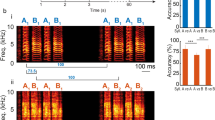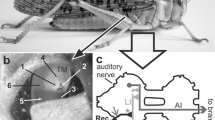Abstract
In the locust the firing rate of tympanal nerve fibres encodes the direction of the sound source, and this has been used as fundamental evidence for the directional sensitivity of each of the tympanal organs1–4. As there is a minute disparity between the two organs (in Locusta this distance is about 4 mm), it was generally accepted that the physical time cue—maximally about 10 µs—cannot be used for sound localisation. However, Mörchen et al. have found that in single receptor fibres of the locust, the magnitude of excitation is highly correlated with the latency of nervous activity5. In their study a sound source was moved around the animal and the latency of a neural discharge increased by up to 6 ms as the firing rate decreased. This ‘neural time cue’ exceeded the physical one by a factor of 100–1,000. Comparison of the inputs from the two organs shows that there are two neural codes available (spike count and latency), each of which can adequately specify the direction of the sound source. We report here that the subsequent synapses process this dual mode of directional coding and that both the rate of binaural spike discharges and latency differences influence the activity of auditory interneurones.
Similar content being viewed by others
References
Miller, L. A. J. comp. Physiol. 119, 85–98 (1977).
Römer, H. J. comp. Physiol. 109, 101–122 (1976).
Autrum, H., Schwartzkopff, J. & Swoboda, H. Biol. Zbl. 80, 385–402 (1961).
Pumphrey, R. J. biol. Rev. 15, 107–132 (1940).
Mörchen, A., Rheinlaender, J. & Schwartzkopff, J. Naturwissenschaffen 65, 656 (1978).
Kalmring, K. J. comp. Physiol. 104, 103–159 (1975).
Lewis, D. B. J. exp. Biol. 60, 839–851 (1974).
Michelsen, A. J. comp. Physiol. 71, 63–101 (1971).
Erulkar, S. D. Physiol. Rev. 52, 237–360 (1972).
Michelsen, A. in Basic Mechanisms in Hearing (ed. Møller, A. R.) 911–933 (Academic, New York, 1973).
Adams, W. B. J. exp. Biol. 57, 297–304 (1972).
Larsen, O. N. & Michelsen, A. J. comp. Physiol. 123, 217–227 (1978).
Author information
Authors and Affiliations
Rights and permissions
About this article
Cite this article
Rheinlaender, J., Mörchen, A. ‘Time–intensity trading’ in locust auditory interneurones. Nature 281, 672–674 (1979). https://doi.org/10.1038/281672a0
Received:
Accepted:
Issue Date:
DOI: https://doi.org/10.1038/281672a0
- Springer Nature Limited
This article is cited by
-
Neurophysiology goes wild: from exploring sensory coding in sound proof rooms to natural environments
Journal of Comparative Physiology A (2021)
-
Directional hearing: from biophysical binaural cues to directional hearing outdoors
Journal of Comparative Physiology A (2015)
-
Spatial orientation in the bushcricket Leptophyes punctatissima (Phaneropterinae; Orthoptera): III. Peripheral directionality and central nervous processing of spatial cues
Journal of Comparative Physiology A (2007)
-
Diversity of intersegmental auditory neurons in a bush cricket
Journal of Comparative Physiology A (2006)
-
Sensory cues for sound localization in the cricket Teleogryllus oceanicus: interaural difference in response strength versus interaural latency difference
Journal of Comparative Physiology A (2003)





